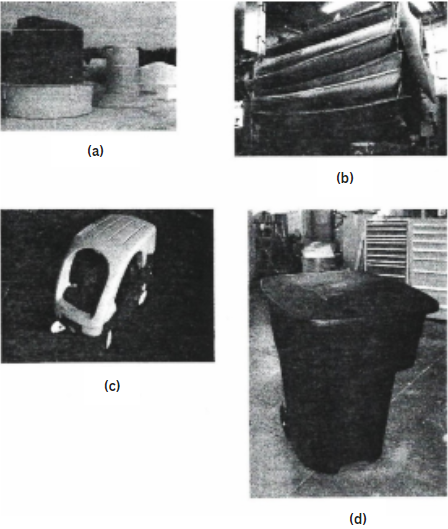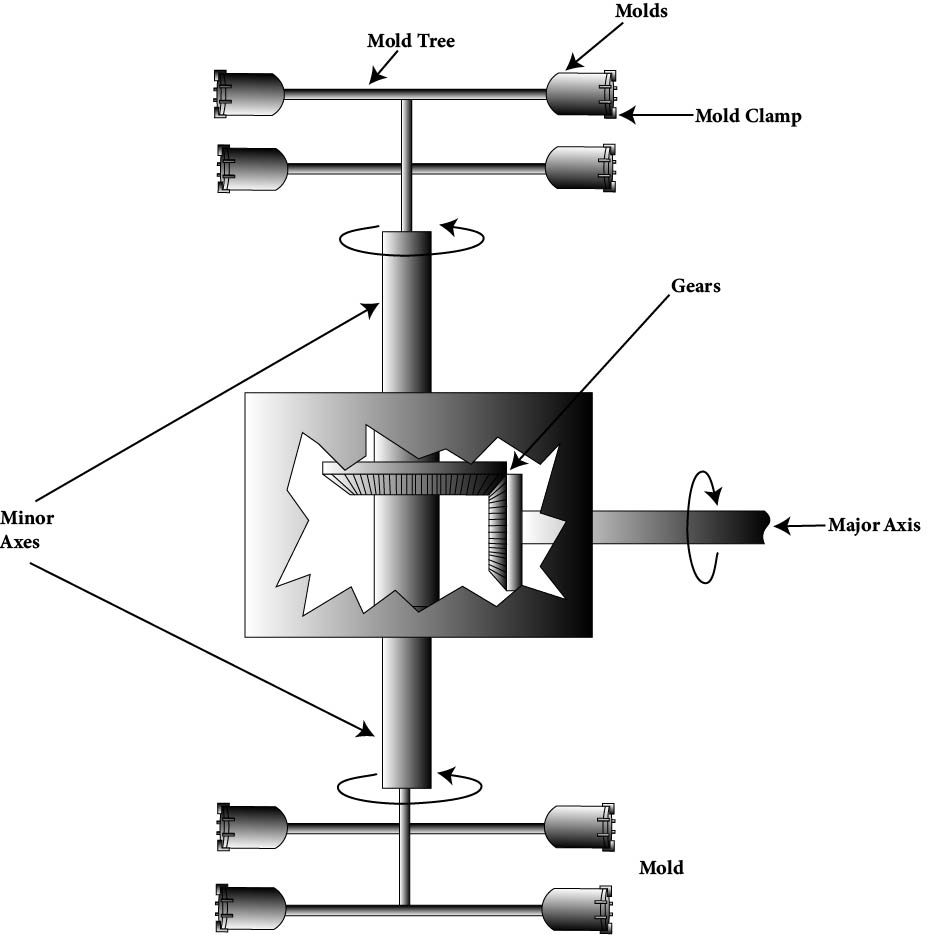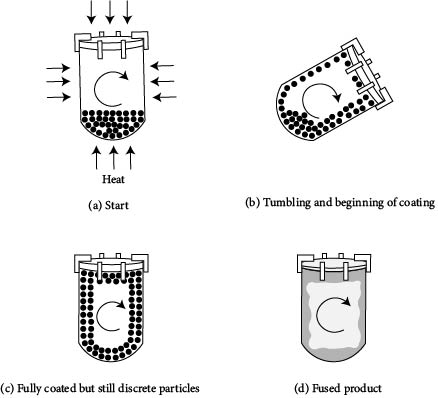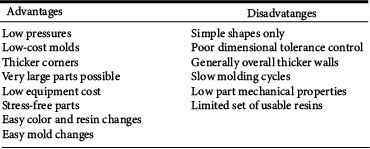Introduction
The rotational molding process, often called rotomolding, uses the rotation of a mold in a heated chamber to form the part. Rotational molding is ideally suited to the formation of very large, seamless, and stress-free hollow parts, such as 25,000-gallon (100,000-L) agricultural tanks, although the process has also been used to make parts as small as ping-pong balls. Some typical rotomolded products are shown in Photo 15.1.
The rotomolding process uses no pressure and so the molds can be simple and inexpensive. Most processes that use no pressure are called casting or cast molding. In that sense, rotational molding is a type of casting and is sometimes called rotational casting. But because of the growing importance of the rotational molding process, it has been separated from the casting chapter in this text. The temperatures used in rotational molding can be lower than in many of the plastics-molding processes because the plastic is never fully melted. Rotational molding can make parts that are functionally competitive with those made by other processes, such as injection molding and blow molding, and offers some unique processing advantages that, in some cases, give capabilities not possible with the other processes. Likewise, rotational molding has some limitations that must be accounted for in making parts. These advantages and disadvantages will be discussed in detail after the rotational molding process itself is explained.


15.1.1. The Rotational Molding Process
The rotational molding process has four principle steps: (1) loading, (2) heating, (3) cooling, and (4) unloading. Several different activities and phenomena occur during each of these steps.
The loading step begins with the careful weighing of a charge of the starting material, which is usually a finely ground thermoplastic powder. Other starting materials, which are not as common, could include dispersions of thermoplastic powders in nonvolatile solvents and even some thermoset resins. The amount of the charge of material is the desired weight of the finished part. The charge of starting material is loaded, usually manually, into an open, usually cold mold that should have been prepared by coating the inside with a mold release agent. After loading, the mold is closed, usually manually, by simply clamping the lid and body of the mold together. The mold is then moved into an oven where it can be heated.


The heating cycle is done in an oven. The heating oven must be large enough that the entire mold assembly can be placed inside it and rotated freely. The mold assembly is rotated continuously throughout the heating and the cooling cycles. The heating cycle for rotational molding is often quite long and so it is common to have multiple molds cycled together. The attachment of several molds to a single assembly that allows all the molds to be rotated together is shown in Figure 15.1. The frame to which the molds are attached is called the mold tree. This arrangement greatly increases the productivity of the rotational molding system, as multiple parts (not always the same product) can be molded simultaneously.
During the heating cycle, the rotation of the mold assembly causes the plastic powder to tumble inside the mold or, more accurately, the walls of the mold to pass under the pool of powder at the bottom of the mold (see Figure 15.2). The plastic powder eventually becomes hot and tacky and begins to stick to the inside of the mold. With additional heating and tumbling, all of the plastic eventually sticks to the walls of the mold. At this stage, the powdered plastic may still be small discrete particles, although some of the resin may also be fluid. With additional heating and rotating, the small particles and fluid join together into a continuous mass. This joining together is called fusion or sintering and occurs because the plastic particles are in a lower energy (more favorable) state when the number of surfaces is reduced. Obviously, the smallest number of surfaces possible is achieved when all the plastic particles have become one solid mass without interior surfaces. Therefore, the preferred energy state occurs when the particles join together or fuse. Note that fusion joins solid materials rather than materials that change to a liquid (molten) state and then resolidify. The particles in rotational molding rarely completely melt; although some liquefaction can occur, the process is still called fusion (or sintering).
The heating cycle is the longest part of the rotational molding process and is, therefore, the rate-determining step. The process of heating the resin and fusing the particles normally takes 7 to 15 minutes, but 30-minute cycles are not uncommon. Large and especially thick parts may require even longer cycles. The cycle increases dramatically with thickness because the buildup of plastic on the walls of the mold acts as an insulating barrier separating the external heating from the resin that is still tumbling in the interior of the mold.


To obtain an even coating of the walls of the mold, the mold must be rotated about more than one axis. Experience has shown that an even coating can be obtained if the rotation is biaxial, that is, about two axes. Biaxial mold rotation is shown in Figure 15.1.
The cooling step occurs after the plastic material has been fully fused. Without stopping the rotation, the mold is transferred to a cooling station where it is cooled as quickly as possible without causing the part to shrink away from the mold. If the part shrinks away from the mold, shape distortion and part surface blemishing may occur. The cooling rate must, therefore, be controlled. This is achieved by the type of cooling medium. Fastest cooling is achieved by spraying cold water over the surface of the mold. Slightly slower cooling occurs when a mist of water is used, and even slower cooling by just blowing air on the mold. Sometimes the mold is cooled with air and then, later in the cycle, is completely cooled with a water spray.
After cooling, the part is transferred out of the cooling chamber to an unloading station. The unloading step is begun by removing the lid of the mold. The cold part is removed manually or, if necessary, with a mechanical assist of some kind. The length of the heating portion of the cycle usually allows time for trimming the part, loading the resin charge for the next part, and closing the mold—all done by a single operator.
15.1.2. Advantages and Disadvantages of Rotational Molding
The advantages and disadvantages of rotational molding compared to other plastic-molding processes are summarized in Table 15.1. One major advantage of rotational molding is the ability to make very large parts with relatively low-cost equipment, an advantage arising from the low pressures involved in rotational molding and the relatively low heat required because the material is not fully melted. The size of parts made by rotational molding is limited only by the size of the oven and cooling chambers and the mechanical capability of rotating the molds.


Table 15.1 Advantages and Disadvantages of the Rotational Molding Process versus Other Plastics-Molding Processes
The shapes that can be handled in rotomolding are more limited than those for injection molding but are of about the same complexity as those that can be made by blow molding or thermoforming. Blow molding and thermoforming are especially competitive with rotomolding for smaller parts and have the advantage of faster cycles. A unique characteristic of rotomolding is that the resin tends to be slightly thicker in the outside corners of a part rather than thinner as with blow molding and thermoforming.
Rotomolding also can make stress-free parts. Because of the low stresses, brittleness is reduced and impact toughness can be improved. However, many factors can eliminate these advantages, especially where impact toughness is concerned. For instance, if the plastic resin is not fully fused, the impact toughness decreases rapidly. Also, the ability of a resin to fuse easily is enhanced by using resins with low molecular weights, but low molecular weights decrease impact toughness. Therefore, impact toughness can be either improved or decreased by rotomolding in comparison with other molding processes.
If parts of equivalent size are to be made, the investment costs of rotational molding are somewhat less than those of injection molding or blow molding and about the same as thermoforming. The low cost of the equipment and the ease of making the mold allow rotomolding to be used to manufacture prototypes, provided, of course, that the part is hollow and fits the other criteria for rotomolding.
Rotomolding allows color changes with every part because the charge is done separately for each part and the mold is clean after each molding. Mold changes are likewise easy to make and can be done rapidly. These easy changes give rotomolding an advantage when production runs are short.
The costs of rotational molding, as with other plastic-molding processes, depend on machine burden (that is, the cost of owning and running the machine) and the labor required to run the parts. These costs are typically related to the number of parts made. In rotational molding, the number of parts quite often depends on the number of molds that are attached to the machine when the parts are molded. That number can vary widely depending on the size of the oven and the number of other parts that might be run at the same time. Therefore, in rotational molding the cost per part depends strongly on the mix of products that are made at the moment. This rather unusual aspect of rotational molding requires that some standard molding configuration be set for each part, taking into account that this configuration may or may not be used with each molding run. The actual cost will vary from time to time and so careful records should be kept to allow actual costs of the part to be calculated. The cost of any single part will need to be calculated in light of other parts that are run at the same time.